The short answer is no; dogs should not eat chocolate in any form. If your pooch has eaten some and you need some quick answers, click on the type of chocolate below:
Cocoa powder | Baking chocolate | Dark chocolate
Milk chocolate | White chocolate | Entire chart
Hopefully, you have a bit of time to read through this at a more leisurely pace.
I’ve been around dogs my entire life, and I’ve often heard that they shouldn’t eat chocolate. “Chocolate will kill a dog” is an oft-repeated phrase I remember from my younger days.
But why? Is chocolate dangerous for dogs? If so, how much?
Do different types of chocolate pose different risks? How can chocolate be toxic for dogs when it tastes so damn good?
Chocolate may be a delight for humans, but for dogs, it’s a hidden danger. Theobromine, found in all types of chocolate, can lead to vomiting, diarrhea, seizures, and even death in our furry friends. Learn why dogs should never eat chocolate, and discover safer alternatives like carob. Protect your canine companion’s health—say ‘No’ to chocolate.
Can dogs eat chocolate?
The short answer is no. Chocolate is dangerous for your dogs and in surprisingly small amounts. So no, dogs should not eat chocolate.
The long answer is a bit more complex.
What makes chocolate dangerous to dogs?
Chocolate and other cocoa products contain “theobromine,” This compound makes chocolate the darker, the better, a healthier snack for humans but potentially lethal for dogs.
The same compounds that cause euphoria in humans can lead to vomiting, diarrhea, and worse for dogs.
It’s important to understand that darker chocolate contains higher concentrations of Theobromine than lighter chocolates.
Milk chocolate, for example, has far less Theobromine than dark chocolate or baking chocolate. Still, remember that for smaller dogs, as little as four ounces of milk chocolate can be fatal.
Given this, it’s obviously best to keep any chocolate away from dogs of any size. We list chocolate very high among the 9 most dangerous foods for dogs.
When cooking for holidays such as Easter, Thanksgiving, and Christmas, when those dark chocolate cooking squares are used, extra caution must be taken to keep that chocolate out of reach of dogs.
If chocolate chips are spilled on the floor when cooking those delicious cookies, don’t let Fido clean up the mess.
Get every single chip up.
Although darker chocolate is more dangerous, it’s important to note that even white chocolate contains Theobromine, so dogs should not eat it.
Theobromine is easily digested and metabolized by humans, but dogs’ metabolism, where this is concerned, is much slower. Consequently, the toxic effects have more time to build up.
They can cause vomiting and diarrhea quickly and often result in what has been called a “theobromine high,” where the dog exhibits severe hyperactivity.
This is often attributed (incorrectly) to a sugar high.
Hyperactivity after eating chocolate is not a “sugar high” but a dangerous symptom
A dog that has eaten any amount of chocolate and goes into fits of higher-than-usual activity may be suffering from early symptoms of the theobromine toxicity build-up.
Symptoms of chocolate toxicity in your dog
A big part of this problem is that often the dog eats the chocolate without you being aware. They find a few chips that fell on the floor, or they pull something off a counter. Or perhaps a toddler is sharing.
The point is that it is often impossible to know exactly how much the dog ate.
After a dog eats chocolate, you are likely to see several symptoms. The onset of any of these signals that the dog’s life is in danger and immediate action is required.
Do not delay; do not wait to see if the dog gets better. Take immediate action, even to the point of an immediate trip to the vet.
- Vomiting
- Diarrhea
- Muscle Tremors
- Rapid breathing
- Seizure
- Muscle rigidity
- Hyperactivity
- Irregular heartbeat
How much and what type of chocolate is dangerous?
Any type and any amount are too much. I’ve seen people give dogs chocolate chips as a reward when training.
Why take the chance?
This is playing with fire; there is no reason to do it when excellent alternatives pose no risk.
So how much?
It’s been reported that a single one-ounce square of dark chocolate can be fatal for a dog of around 40-50 pounds.
There will always be folks who claim this isn’t true because they always give their dog chocolate.
They’ve been fortunate.
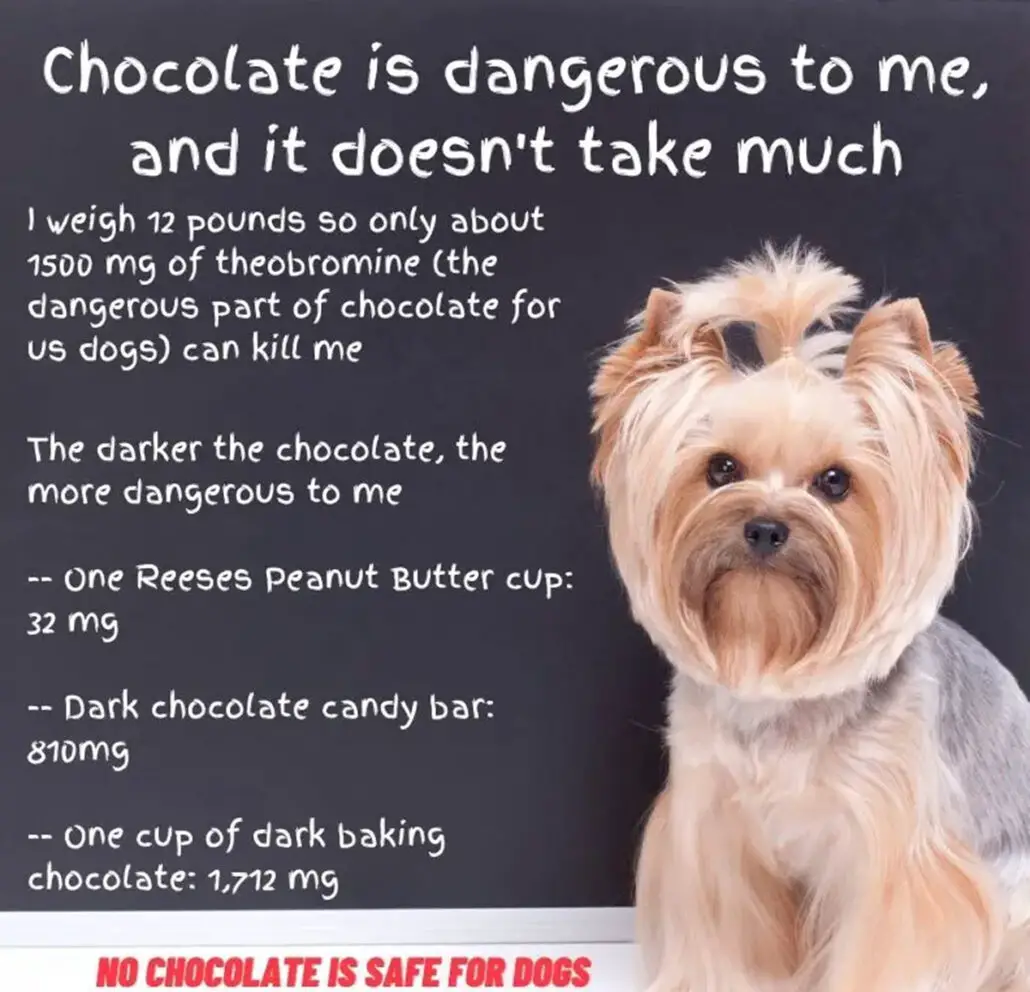
I’ve also seen reports that as little as four ounces of light milk chocolate can be fatal for a small dog. Of course, the reaction time is faster for small dogs, so your timeframe to help the little dog out after eating chocolate is more limited.
There are established levels at which the amount of Theobromine, as compared to your dog’s weight, is considered safe, toxic, and dangerous. These are pretty widely accepted as:
- Less than 20 mg/kg of Theobromine and your dog may show mild effects
- Between 20-60 mg/kg of Theobromine and your dog may show serious effects
- Above 60 mg/kg, your dog is in dire need of veterinarian assistance, and any delay could prove fatal.
The tables below break this down into (hopefully) readable formats based on the different types of chocolate and the dog’s size. What is not accounted for is time. Remember that dogs metabolize Theobromine very slowly, so eating additional chocolate, even over a prolonged period, can add up to bad news.
We don’t consider “Is chocolate bad for my dog” or “Can I feed my dog chocolate” as the main focus here. The answers are “Yes, chocolate is bad for your dog” and “No, you should not feed your dog chocolate.”
What follows is more targeted to the dog owner who has found out their dog has eaten some chocolate and needs to understand the danger involved.
Cocoa powder toxicity for dogs
Cocoa powder can be extremely dangerous for dogs of all sizes, but particularly for smaller dogs and in relatively small doses. We recommend an immediate call to the vet in almost all instances. Find your dog’s size in pounds down the left side of the table and then move across to the amount of Cocoa powder your dog ate to determine the level of danger to your dog.
Below is a breakdown of 1 ounce, 2 ounces, 3 ounces, and 4 ounces. An ounce of cocoa powder is about 2 tablespoons, and 4 ounces is 1/2 cup, so use this as a reference if you are unsure how much may have been eaten.
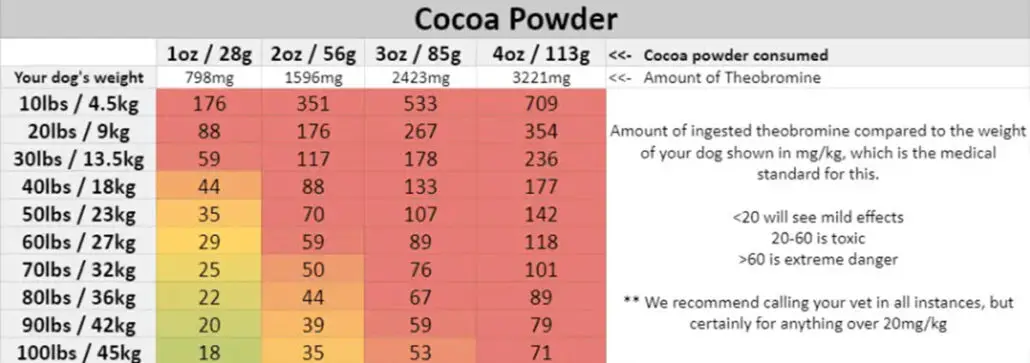
Baking chocolate toxicity for dogs
Baking chocolate is almost as dangerous as Cocoa powder and can be very dangerous in small doses for all sizes of dogs. As with Cocoa powder, we recommend an immediate call to your vet. Find your dog’s size in pounds down the left side of the table and then move across to the amount of Baking Chocolate your dog ate to determine the level of danger to your dog.
Below is a breakdown of 1 ounce, 2 ounces, 3 ounces, and 4 ounces. A full-sized baking chocolate bar is 4 ounces, so use this as a reference if you are unsure how much may have been eaten.
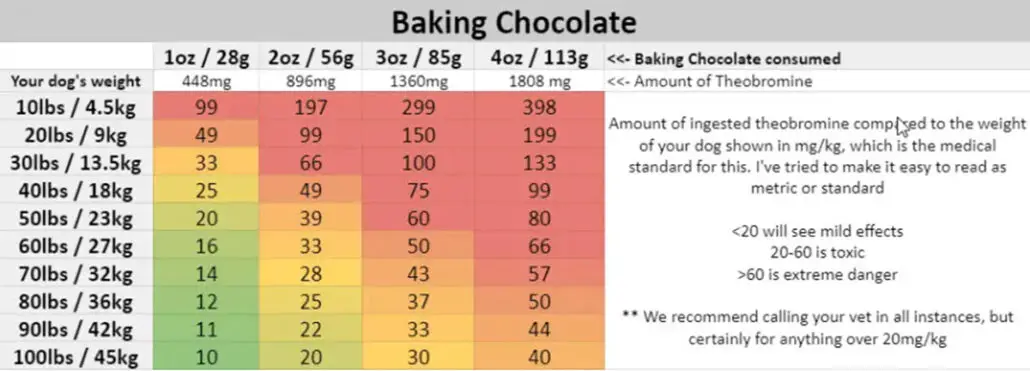
Dark chocolate toxicity for dogs
Dark chocolate is less dangerous than Cocoa powder or Baking chocolate, but it can still be extremely dangerous for your dog. Find your dog’s size in pounds down the left side of the table and then move across to the amount of Dark chocolate your dog ate to determine the level of danger to your dog.
Below is a breakdown of 1 ounce, 2 ounces, 3 ounces, and 4 ounces. A large dark chocolate candy bar is usually 3.5 to 4 ounces, so use this as a reference if you are unsure how much may have been eaten.
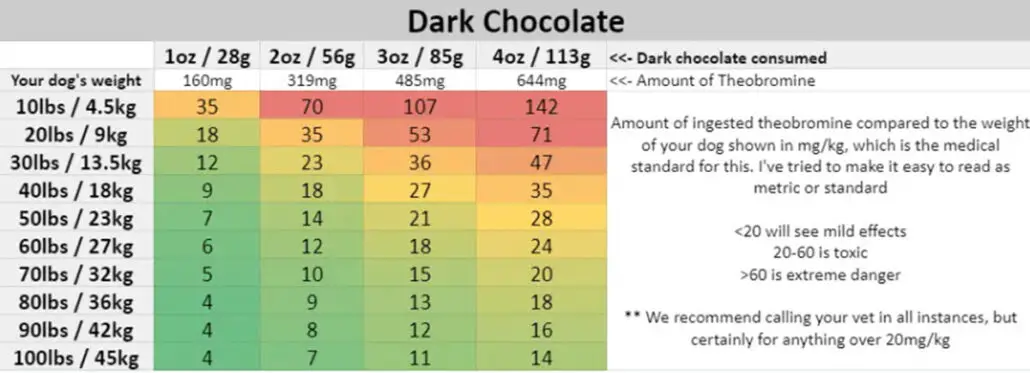
Milk chocolate toxicity for dogs
Milk chocolate has far less Theobromine than darker chocolates, so, as the chart shows, dogs are less affected, and the urgency may be less, depending on the size of the dog and the amount consumed. Find your dog’s size in pounds down the left side of the table and then move across to the amount of Milk chocolate your dog ate to determine the level of danger to your dog.
Below is a breakdown of 1 ounce, 2 ounces, 3 ounces, and 4 ounces. A large milk chocolate candy bar is usually about 2.2 to 3.5 ounces, so use this as a reference if you are unsure how much may have been eaten.

Can dogs eat white chocolate?
The Theobromine in white chocolate, when compared to darker chocolate, is almost non-existent. There is little chance of theobromine poisoning from white chocolate except in very small dogs eating a lot of white chocolate.
Does that mean it’s OK for dogs to eat white chocolate?
No.
For several reasons.
We discussed Theobromine in great detail above, but also in chocolate are sugar, milk, and caffeine. None of these are particularly good for your dog, so just because white chocolate isn’t as bad for your dog as dark chocolate doesn’t mean feeding it to your dog is OK.
So no, your dog should not eat white chocolate.
Chocolate toxicity for dogs across all dog sizes and types of chocolate
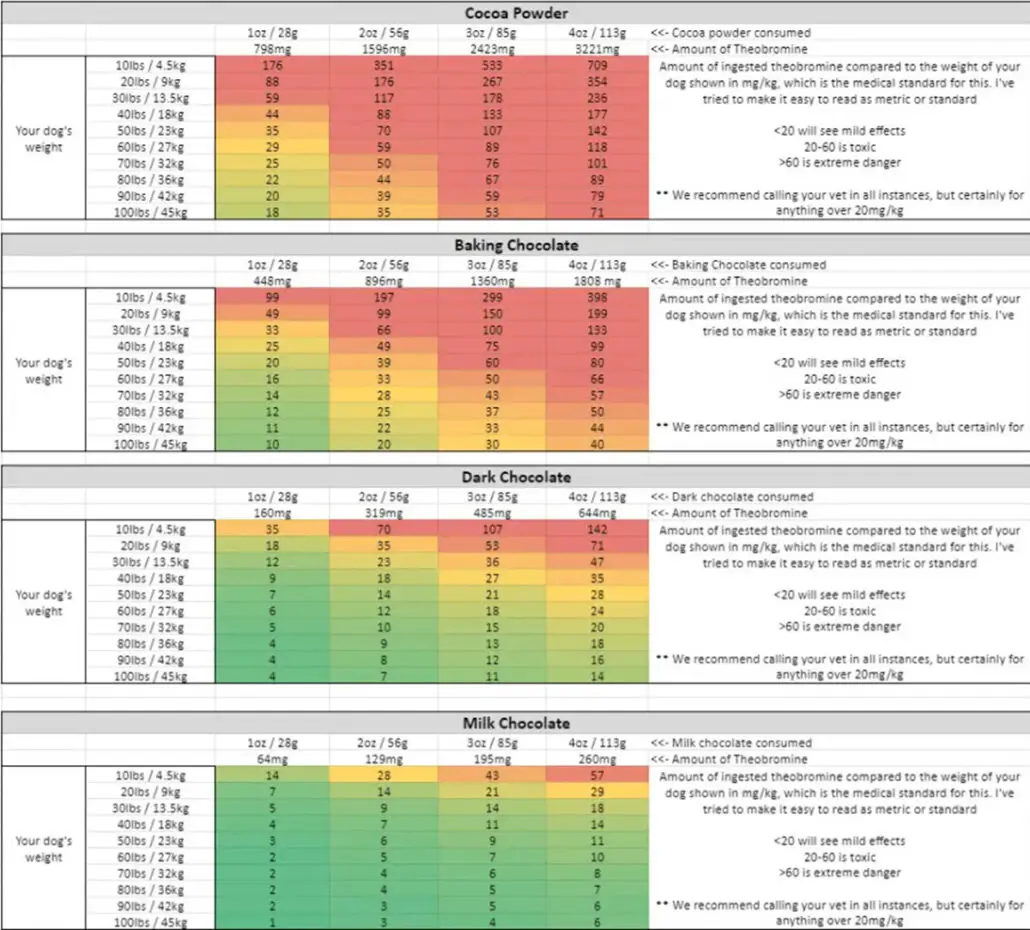
The tables behind the data in the images above follow – I’ve shaded the danger areas as red and the high-caution areas as yellow for quick reference. Please note that extreme caution should always be taken. We advise erring on the side of being overly cautious and calling your vet regardless of what these charts or any other toxicity calculator show.
| Cocoa Powder | ||||||
| 1oz / 28g | 2oz / 56g | 3oz / 85g | 4oz / 113g | <<- Cocoa powder consumed | ||
| 798mg | 1,596mg | 2,423mg | 3,221mg | <<- Amount of Theobromine | ||
|
Your dog’s weight
| 10lbs / 4.5kg | 176 | 351 | 533 | 709 | The amount of ingested Theobromine compared to your dog’s weight is shown in mg/kg, the medical standard. I’ve tried to make it easy to read as metric or standard <20 will see mild effects 20-60 is toxic >60 is extreme danger ** We recommend calling your vet in all instances, but certainly for anything over 20mg/kg |
| 20lbs / 9kg | 88 | 176 | 267 | 354 | ||
| 30lbs / 13.5kg | 59 | 117 | 178 | 236 | ||
| 40lbs / 18kg | 44 | 88 | 133 | 177 | ||
| 50lbs / 23kg | 35 | 70 | 107 | 142 | ||
| 60lbs / 27kg | 29 | 59 | 89 | 118 | ||
| 70lbs / 32kg | 25 | 50 | 76 | 101 | ||
| 80lbs / 36kg | 22 | 44 | 67 | 89 | ||
| 90lbs / 42kg | 20 | 39 | 59 | 79 | ||
| 100lbs / 45kg | 18 | 35 | 53 | 71 | ||
| Baking Chocolate | ||||||
| 1oz / 28g | 2oz / 56g | 3oz / 85g | 4oz / 113g | <<- Baking Chocolate consumed | ||
| 448mg | 896mg | 1,360mg | 1,808 mg | <<- Amount of Theobromine | ||
|
Your dog’s weight
| 10lbs / 4.5kg | 99 | 197 | 299 | 398 | The amount of ingested Theobromine compared to your dog’s weight is shown in mg/kg, the medical standard. I’ve tried to make it easy to read as metric or standard. <20 will see mild effects 20-60 is toxic >60 is extreme danger ** We recommend calling your vet in all instances, but certainly for anything over 20mg/kg |
| 20lbs / 9kg | 49 | 99 | 150 | 199 | ||
| 30lbs / 13.5kg | 33 | 66 | 100 | 133 | ||
| 40lbs / 18kg | 25 | 49 | 75 | 99 | ||
| 50lbs / 23kg | 20 | 39 | 60 | 80 | ||
| 60lbs / 27kg | 16 | 33 | 50 | 66 | ||
| 70lbs / 32kg | 14 | 28 | 43 | 57 | ||
| 80lbs / 36kg | 12 | 25 | 37 | 50 | ||
| 90lbs / 42kg | 11 | 22 | 33 | 44 | ||
| 100lbs / 45kg | 10 | 20 | 30 | 40 | ||
| Dark Chocolate | ||||||
| 1oz / 28g | 2oz / 56g | 3oz / 85g | 4oz / 113g | <<- Dark chocolate consumed | ||
| 160mg | 319mg | 485mg | 644mg | <<- Amount of Theobromine | ||
|
Your dog’s weight
| 10lbs / 4.5kg | 35 | 70 | 107 | 142 | The amount of ingested Theobromine compared to your dog’s weight is shown in mg/kg, which is the medical standard. I’ve tried to make it easy to read as metric or standard. <20 will see mild effects 20-60 is toxic >60 is extreme danger ** We recommend calling your vet in all instances, but certainly for anything over 20mg/kg |
| 20lbs / 9kg | 18 | 35 | 53 | 71 | ||
| 30lbs / 13.5kg | 12 | 23 | 36 | 47 | ||
| 40lbs / 18kg | 9 | 18 | 27 | 35 | ||
| 50lbs / 23kg | 7 | 14 | 21 | 28 | ||
| 60lbs / 27kg | 6 | 12 | 18 | 24 | ||
| 70lbs / 32kg | 5 | 10 | 15 | 20 | ||
| 80lbs / 36kg | 4 | 9 | 13 | 18 | ||
| 90lbs / 42kg | 4 | 8 | 12 | 16 | ||
| 100lbs / 45kg | 4 | 7 | 11 | 14 | ||
| Milk Chocolate | ||||||
| 1oz / 28g | 2oz / 56g | 3oz / 85g | 4oz / 113g | <<- Milk chocolate consumed | ||
| 64mg | 129mg | 195mg | 260mg | <<- Amount of Theobromine | ||
|
Your dog’s weight
| 10lbs / 4.5kg | 14 | 28 | 43 | 57 | The amount of ingested Theobromine compared to your dog’s weight is shown in mg/kg, which is the medical standard. I’ve tried to make it easy to read as metric or standard <20 will see mild effects 20-60 is toxic >60 is extreme danger ** We recommend calling your vet in all instances, but certainly for anything over 20mg/kg |
| 20lbs / 9kg | 7 | 14 | 21 | 29 | ||
| 30lbs / 13.5kg | 5 | 9 | 14 | 18 | ||
| 40lbs / 18kg | 4 | 7 | 11 | 14 | ||
| 50lbs / 23kg | 3 | 6 | 9 | 11 | ||
| 60lbs / 27kg | 2 | 5 | 7 | 10 | ||
| 70lbs / 32kg | 2 | 4 | 6 | 8 | ||
| 80lbs / 36kg | 2 | 4 | 5 | 7 | ||
| 90lbs / 42kg | 2 | 3 | 5 | 6 | ||
| 100lbs / 45kg | 1 | 3 | 4 | 6 | ||
Here’s a sampling of how much Theobromine can be found in common chocolate items you have in your house
| Item | Serving Size | Theobromine content |
| Rich Chocolate Ice Cream | 1 cup | 178 mg |
| Chocolate pudding | 1 cup | 75 mg |
| Hershey’s milk chocolate bar | 1.5 oz | 64 mg |
| Reese’s Peanut Butter Cup | 2 cups | 32 mg |
| Baking Chocolate | 1 cup | 1712 mg |
| Dark chocolate candy bar | 1 bar | 810 mg |
| Dry cocoa chocolate baking powder | 1 cup | 1769 mg |
When you look at the above table and see that a single Reese’s Peanut Butter cup has about 32 mg of Theobromine, you may think that’s below the threshold, so it’s OK.
And it might be. But again, why take the chance when there are so many excellent, undoubtedly safe alternatives?
Also, you know how dogs are. They get a taste, and they want more.
Just don’t go down that road. There’s not a single good reason to take that risk.
What to do when your dog eats chocolate?
Much of this depends on the dog’s size, the amount of chocolate consumed, and what kind of chocolate.
Try to figure out what type of chocolate it was. If you can find a wrapper, that will be very helpful. Also, note how much was eaten, if you know. These two bits of information will be very important for your trip to the vet.
Small dogs should be taken to a vet immediately, regardless of how much chocolate was consumed.
This is the safest approach as, for small dogs, relatively small amounts of chocolate can be very dangerous.
For larger dogs, you have a bit of breathing room.
If you know that only a small amount was eaten and know what kind of chocolate (remember, darker is worse in this case), you may be OK just keeping an eye on the pooch and watching for symptoms (listed above).
Inducing vomiting is recommended if you catch the dog within 2 hours or so. Beyond 2 hours, inducing vomiting won’t help much. If you catch your dog red-handed or red-pawed, I guess the best thing you can do is induce vomiting to get that chocolate out of the dog’s system.
As far as the different types of chocolate, as mentioned previously, the darker the chocolate, the higher the theobromine concentration and, therefore, the more dangerous it is for dogs.
Dark baking chocolate contains about six times as much as the lighter milk chocolate in candy bars. The point is that a single one-ounce piece of dark chocolate can introduce six times as much Theobromine into your dog’s system, making the symptoms much faster and more severe.
Dog-safe alternative to chocolate
We now understand why chocolate is dangerous for dogs to eat and have agreed never to feed chocolate to our furry friends, right?
But are there alternatives?
Actually, there is. Carob is a dog-safe chocolate alternative that is healthy and safe for dogs. We wrote an entire article about it.
Can dogs eat chocolate – conclusion

So is chocolate dangerous for dogs? Undeniably so.
Can dogs eat chocolate?
Given the gray area (how much, what kind of chocolate, how big is the dog, etc.), many owners feel safe, but again, why take the chance?
Plenty of alternatives are 100% safe, so go that route instead. Our final and strongest recommendation is never to feed your dog any chocolate.
We often hear, “Can dogs eat [fill in the blank],” so we are working on a series of articles to discuss these topics. Please see our additional articles on our main dog health page.
Also, for a more informative overview about what your dog should and should not eat, look at our “Can dogs eat…” article, where we cover over 80 different items.
We take this stuff seriously and research before sharing it with you.
- National Institute of Health, National Library of Medicine
- American Kennel Club (AKC)
- Boston Veterinary Clinic
- VCA Animal Hospitals
- Chocolate Poisoning in Dogs
- Renee Schmid, DVM
- Ahna Brutlag, DVM, MS, DABT, DABVT Pet Poison Helpline
- Chocolate Poisoning in Dogs
- McGill – Office for Science and Society
- Vets Now
- Aug 2018 – First published
- Mar 2022 – Updated
- May 2023 – Updated
